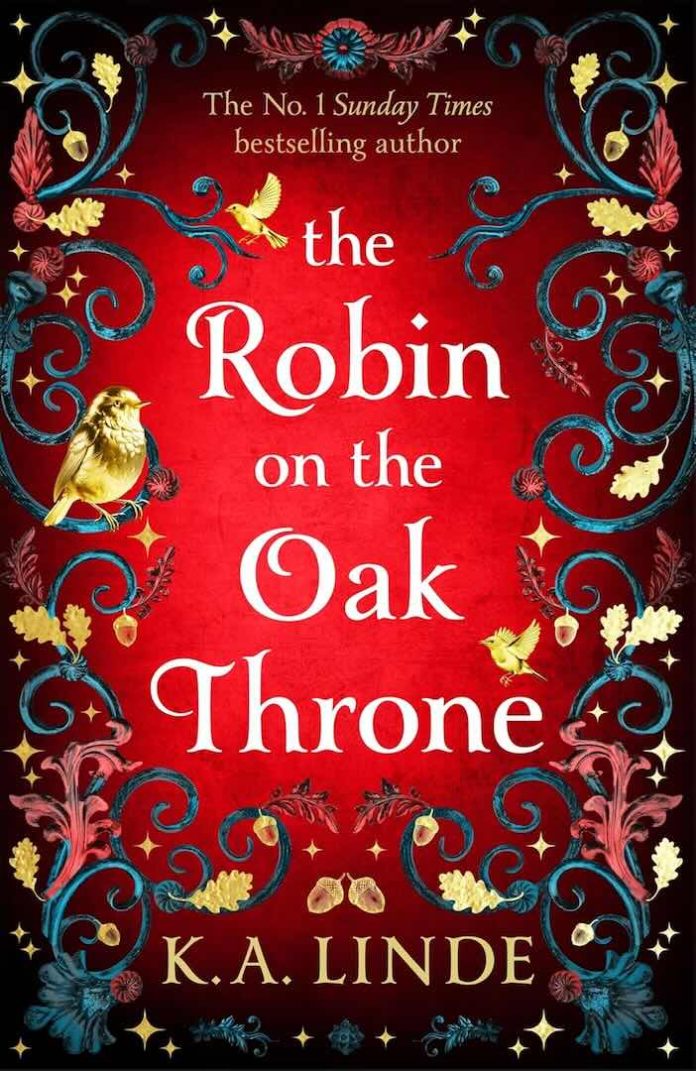K.A. Linde’s The Robin on the Oak Throne emerges as a masterful continuation of her Oak and Holly Cycle, elevating the stakes and emotional complexity far beyond its predecessor, The Wren in the Holly Library. Where the first book established the magical foundation and introduced us to Kierse McKenna’s journey of self-discovery, this sequel plunges readers into a labyrinthine world of political intrigue, ancient mythology, and moral ambiguity that refuses to offer easy answers.
The second installment opens with Kierse breaking the Monster Treaty once again—this time stealing a goblin-made bracelet from the Queen of the Nymphs in her own palace. Yet what begins as a seemingly straightforward heist becomes the catalyst for a much larger exploration of power, identity, and the cost of truth. Linde demonstrates remarkable growth in her worldbuilding, expanding the scope from the contained drama of New York’s supernatural underworld to a European landscape where ancient Celtic magic pulses beneath modern sensibilities.
The Evolution of Kierse McKenna
Perhaps the most compelling aspect of this novel is watching Kierse grapple with the revelations from the first book while navigating increasingly complex moral terrain. No longer the confused thief discovering her magical heritage, Kierse has evolved into a formidable character who must reconcile her past trauma with her growing power as a half-wisp. Linde skillfully balances Kierse’s vulnerability—particularly in scenes involving recovered memories of her parents—with her fierce independence and survival instincts.
The memory sequences, revealed through her magical connection with Graves, serve as some of the novel’s most emotionally resonant moments. When Kierse finally witnesses the truth about her parents’ fate, Linde’s prose becomes almost lyrical in its restraint, allowing the emotional weight to speak for itself rather than overwhelming readers with melodrama. The recovery of her father’s hunting knife—”blessed by the Fae” and bearing a Trinity Knot—becomes a powerful symbol of her reclaimed identity.
The Holly King’s Redemption Arc
Graves remains one of fantasy romance’s most intriguing antiheroes. His centuries-old conflict with Lorcan, the Oak King, provides the mythological backbone that elevates this series beyond typical urban fantasy fare. Linde excels at peeling back layers of his character without completely removing the dangerous edge that makes him compelling. His relationship with Kierse has matured from the manipulative dynamic of the first book into something more complex—a partnership built on mutual respect, shared trauma, and genuine affection.
The scenes between Graves and Kierse crackle with tension that feels both romantic and adversarial. Their chemistry is undeniable, yet Linde never lets readers forget the power imbalances and past betrayals that complicate their connection. When Graves admits to hiding Kierse’s true identity, the revelation doesn’t feel like a cheap plot twist but rather an inevitable consequence of his protective instincts warring with his manipulative nature.
Lorcan Flynn: The Seductive Antagonist
If Graves is shadow and winter, Lorcan Flynn embodies the dangerous allure of summer and growth. As the Oak King and leader of the Druidic Order, he presents perhaps one of the most sophisticated antagonists in recent fantasy literature. His offer to Kierse—a place beside him on the Oak Throne, reunification with her chosen family, access to wisp knowledge—isn’t simply villainous scheming but represents a genuinely appealing alternative to her current path.
Linde’s portrayal of Lorcan’s Brooklyn stronghold, with its magical oak throne room that exists as a pocket of ancient Ireland, showcases her ability to blend urban fantasy with high fantasy elements seamlessly. The scenes where Kierse explores this sanctuary feel mythic and intimate simultaneously, highlighting the author’s skill at creating spaces that serve both plot function and emotional resonance.
The revelation that Niamh serves as Lorcan’s “robin”—the Oak King’s equivalent to Kierse’s role as Graves’s “wren”—adds another layer of complexity to the mythology while deepening the sense of cosmic balance that drives the Celtic seasonal magic system.
Supporting Characters and World Expansion
The supporting cast has grown more nuanced and integral to the plot. Gen and Ethan’s development as High Priestess and Druid respectively provides emotional stakes beyond the central romance, while their triskel bond with Kierse creates opportunities for magical cooperation that feel organic rather than convenient. The friendship dynamics feel authentic, particularly Gen’s concerns about Kierse’s safety and Ethan’s struggle to balance loyalty to his friends with his Druidic training.
Nate’s continued presence as a werewolf ally navigating the political complexities of Monster politics adds depth to the worldbuilding, while new characters like Laz and Isolde expand the sense of Graves having a life and history beyond his obsession with Kierse and Lorcan.
Mythological Depth and Celtic Magic
Linde’s incorporation of Celtic mythology goes far beyond surface-level appropriation. The Oak and Holly King cycle, traditionally representing the eternal struggle between summer and winter, becomes a deeply personal conflict between two characters whose centuries-old enmity has shaped both their natures and the magical world around them. The author demonstrates clear research into Celtic lore while making it accessible to readers unfamiliar with the source material.
The magic system continues to impress with its internal consistency and emotional resonance. Kierse’s absorption abilities, Graves’s connection to knowledge and shadow, and Lorcan’s nature magic all feel distinct while operating within a coherent magical framework. The seasonal aspects of their power—how the approaching solstice affects their abilities—creates natural tension and urgency within the plot structure.
Areas for Critical Assessment
While The Robin on the Oak Throne excels in character development and mythological depth, it occasionally suffers from pacing issues common to middle books in a series. The extensive setup for future conflicts sometimes slows the narrative momentum, particularly in the middle sections where characters spend considerable time in exposition-heavy conversations about magical politics and ancient history.
The romance, while compelling, occasionally overwhelms the plot progression. Some readers may find the will-they-won’t-they dynamics between Kierse and both Graves and Lorcan somewhat repetitive, though the emotional authenticity of these relationships generally carries the romantic elements effectively.
Additionally, while the European setting provides fresh scenery, some of the cultural details feel less lived-in than the vividly realized New York supernatural community from the first book. The Paris sequences, while atmospherically described, lack the gritty authenticity that made the Brooklyn Druid compound so memorable.
Thematic Resonance
Beyond the surface-level romance and supernatural action, Linde explores themes of identity, trauma recovery, and the complexity of found family relationships. Kierse’s journey involves not just discovering her magical heritage but learning to trust others after a childhood marked by abandonment and abuse. The parallel between her relationship with Graves—built on lies that were intended to protect—and her growing understanding of her parents’ choices creates emotional depth that elevates the material.
The exploration of power dynamics, both romantic and political, feels particularly relevant. Neither Graves nor Lorcan can simply command Kierse’s loyalty; she must choose her path based on her own values and desires. This agency makes her character compelling beyond her magical abilities.
Technical Craft and Writing Style
Linde’s prose has matured considerably since the first book, showing greater confidence in both action sequences and intimate character moments. Her dialogue feels natural and distinct for each character, while her descriptive passages create vivid sensory experiences without overwhelming the narrative flow. The alternating perspectives and flashback sequences are handled skillfully, maintaining clarity while building emotional investment.
The author’s handling of trauma, particularly Kierse’s recovered memories and past experiences, demonstrates sensitivity and authenticity. Rather than exploiting traumatic elements for shock value, Linde uses them to deepen character understanding and motivation.
Comparison Within the Series and Genre
The Robin on the Oak Throne represents a significant step forward from The Wren in the Holly Library, showing greater confidence in balancing multiple plot threads and character arcs. Where the first book sometimes felt constrained by the need to establish its world and rules, this sequel feels free to explore the implications and complications of the mythology Linde has created.
Within the broader urban fantasy romance genre, this series distinguishes itself through its sophisticated approach to mythology and its refusal to simplify complex emotional dynamics. While it shares DNA with works like Patricia Briggs’s Mercedes Thompson series or Ilona Andrews’s Kate Daniels books, Linde’s focus on Celtic mythology and seasonal magic creates a distinctive flavor.
Readers familiar with Linde’s previous works, including her Royal Houses series (House of Dragons, House of Shadows, House of Curses, House of Gods) and Ascension series (The Affiliate, The Bound, The Consort, The Society, The Domina), will recognize her talent for creating epic romantic fantasy, though the Oak and Holly Cycle represents perhaps her most mature work to date.
Similar Reading Recommendations
Readers who enjoyed The Robin on the Oak Throne should consider:
- The Iron Druid Chronicles by Kevin Hearne – for Celtic mythology in modern settings
- The October Daye series by Seanan McGuire – for complex urban fantasy with fairy tale elements
- The Kate Daniels series by Ilona Andrews – for similar blend of magic, romance, and urban fantasy
- The Rivers of London series by Ben Aaronovitch – for mythology meeting modern city life
- The Hollows series by Kim Harrison – for supernatural politics and complex relationships
- American Gods by Neil Gaiman – for mythological depth and character-driven fantasy
Final Verdict
The Robin on the Oak Throne succeeds as both a worthy sequel and a compelling standalone narrative within the Oak and Holly Cycle. While it occasionally struggles with the middle-book burden of setup and transition, its strengths—particularly in character development, mythological depth, and emotional authenticity—far outweigh its weaknesses.
Linde has crafted a story that honors its Celtic roots while creating something distinctly contemporary. The book rewards careful readers with its layered mythology and complex character relationships, while providing enough action and romance to satisfy those seeking pure entertainment. Most importantly, it sets up what promises to be an explosive conclusion to the trilogy while delivering a satisfying reading experience in its own right.
For fans of urban fantasy romance seeking something more substantial than typical offerings in the genre, The Robin on the Oak Throne delivers intellectual depth alongside emotional satisfaction. It confirms K.A. Linde’s position as a significant voice in contemporary fantasy romance and leaves readers eagerly anticipating the trilogy’s conclusion.
The book earns its place as a worthy continuation of what promises to be a standout series in the urban fantasy romance genre, proving that mythology, when handled with care and creativity, can breathe new life into familiar romantic fantasy tropes.





